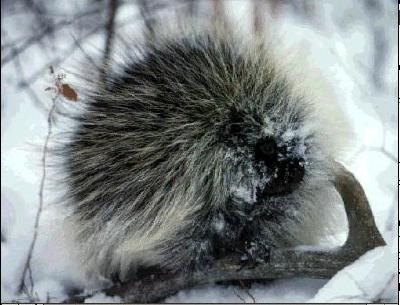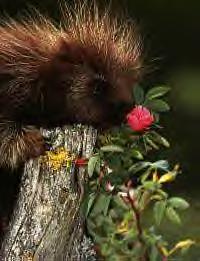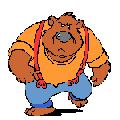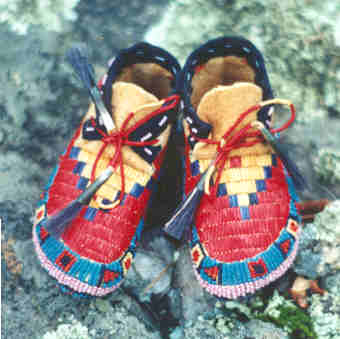|
 When
we are lucky enough to spot most mammals, its usually as they are running away. But porcupines like to sit quietly
in trees, so if they live in your area and you spot one, you're likely to get a pretty long look. Even when porcupines
are on the ground, they shuffle and waddle along—this animal doesn't need speed. The thousands of quills it carries
on its back provide plenty of protection from predators. When
we are lucky enough to spot most mammals, its usually as they are running away. But porcupines like to sit quietly
in trees, so if they live in your area and you spot one, you're likely to get a pretty long look. Even when porcupines
are on the ground, they shuffle and waddle along—this animal doesn't need speed. The thousands of quills it carries
on its back provide plenty of protection from predators.
The porcupine is a medium-sized rodent, related to mice and rats and beaver. An adult animal is about 50 cm long
(20 inches,) not counting the tail, and weighs from 4.5 to 13 kg (10 to 28 pounds.) Long black and brown guard
hairs cover its body and quills are mixed in among them. Quills are really modified hairs.
Porcupines are nocturnal, which means they are actively primarily at night. In winter they like to munch on bark
and evergreen needles. In summer they wander around fields and orchards in search of warm weather snacks, such
as grasses, leaves, dandelions, clover and other wildflowers. Porcupines can swim, so pond weeds, water lilies,
and arrowhead are all part of the summer diet.
Porcupines enjoy munching on a variety of trees--hemlock, fir, and pine, as well as maple, beech, birch, oak, elm,
cherry and willow. They also eat all kinds of woody shrubs. These animals have been known to gnaw on other wood
objects, such as old boards and even houses. They are attracted by salt and may chew on any tool handle that has
salt left from human sweat.
 When not in trees or feeding, porcupines prefer the protection of a den. Dens can be found in rock
crevices, caves, hollow logs, abandoned mines, and even under houses and barns. When not in trees or feeding, porcupines prefer the protection of a den. Dens can be found in rock
crevices, caves, hollow logs, abandoned mines, and even under houses and barns.
Of course, the most famous characteristic of this animal are the quills. When a porcupine is threatened, it assumes
a defensive posture—head and shoulders lowered, back to the threat, every quill erect, tail thrashing back and
fourth. This is usually enough to scare away any would-be predator. Quills come out of the porcupine's skin easily,
but they quickly become embedded in the enemy, working their way in deeper and deeper. Not only is this painful,
it can be fatal.
In spite of this prickly suit of armor, there are some animals that prey on porcupines. The fisher is the most
formidable predator, but great horned owls, coyotes, bobcats, mountain lions, and wolves will make a meal out of
the porcupine if there's an opportunity.
Porcupines live in most of the western United States and parts of the Northeast, and throughout Canada.
 Quick
Facts: Quick
Facts:
- Porcupines can NOT throw their quills.
- Porcupine vision is poor, but they have an excellent sense of smell.
- Porcupines make shrill screeches, whines, and low grunts.
- Porcupines are vegetarians, and they eat a large variety of plants, shrubs and trees.
- Baby porcupines are called "porcupettes."
- Porcupines are not territorial, and their home range may be as large as 200 acres.
- A group of porcupines (or hedgehogs, actually) is called a "prickle
|

 Long
ago, when the world was young, porcupines had no quills. One day when Porcupine was in the woods, Bear came along
and wanted to eat him. But Porcupine climbed to the top of a tree and was safe.
Long
ago, when the world was young, porcupines had no quills. One day when Porcupine was in the woods, Bear came along
and wanted to eat him. But Porcupine climbed to the top of a tree and was safe.
 When
we are lucky enough to spot most mammals, its usually as they are running away. But porcupines like to sit quietly
in trees, so if they live in your area and you spot one, you're likely to get a pretty long look. Even when porcupines
are on the ground, they shuffle and waddle along—this animal doesn't need speed. The thousands of quills it carries
on its back provide plenty of protection from predators.
When
we are lucky enough to spot most mammals, its usually as they are running away. But porcupines like to sit quietly
in trees, so if they live in your area and you spot one, you're likely to get a pretty long look. Even when porcupines
are on the ground, they shuffle and waddle along—this animal doesn't need speed. The thousands of quills it carries
on its back provide plenty of protection from predators.  When not in trees or feeding, porcupines prefer the protection of a den. Dens can be found in rock
crevices, caves, hollow logs, abandoned mines, and even under houses and barns.
When not in trees or feeding, porcupines prefer the protection of a den. Dens can be found in rock
crevices, caves, hollow logs, abandoned mines, and even under houses and barns.  Quick
Facts:
Quick
Facts: A technique
practiced for centuries in many parts of North America, quillwork was the primary form of decoration for the majority
of tribes living in areas where the porcupine (the second largest rodent in North America) could be found. Colored,
geometric bands of quills were folded and twisted to make complex patters on baskets, in jewellery or on gloves.
Around 1840, quillworking began to decline when native women started using beads to decorate garments.
A technique
practiced for centuries in many parts of North America, quillwork was the primary form of decoration for the majority
of tribes living in areas where the porcupine (the second largest rodent in North America) could be found. Colored,
geometric bands of quills were folded and twisted to make complex patters on baskets, in jewellery or on gloves.
Around 1840, quillworking began to decline when native women started using beads to decorate garments.